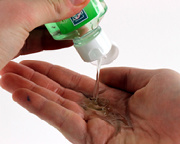Every year, studies show that many employees are injured while carrying out their duties. Some even die from job-related illnesses or injuries.

Medical and dental office staff members face many risks on the job, such as contracting bloodborne illnesses from needles or sharps; being injured by diagnostic equipment; and suffering allergic reactions from toxic chemicals used in labs.
To help ensure the safety of your employees and to avoid liability, doctors must pay attention to the guidelines for physicians' offices that are laid out by the Occupational Safety and Health Administration (OSHA), the federal agency charged with protecting American workers.
Here are six OSHA guidelines that address the operation of medical and dental offices:
1. Blood-borne pathogens - To keep staff members safe from diseases passed through contact with human blood, OSHA requires medical groups to develop an Exposure Control Plan, which outlines the practices' procedures for safely handling blood-tainted waste material. The plan should include the use of the latest technology in needles, which are designed to help avoid injuries to health care providers. Your practice should require the use of proper protective equipment, such as gloves, face masks, safety goggles and gowns. OSHA's requirements also call for medical practices to provide hepatitis B vaccinations to exposed staffers and training on how to avoid exposure to that and other bloodborne diseases.
2. Electrical equipment - To help protect employees from electrocution or explosion, medical offices are required to properly install and inspect sources of electrical power for equipment and to provide safe spaces to operate sterilizers, ECG, X-Ray and other machines. Additional rules apply to practices that use special equipment, such as lasers.
3. Hazardous materials - Medical practices are required to create a written list of hazardous chemicals stored on the premises and make it available to all employees. Materials include disinfectants, sterilizing solutions or anesthetic agents. For each hazardous substance, employees are entitled to have access to the Material Safety Data Sheet, which federal law requires chemical makers to provide to users. Those sheets give information on how to safely handle the substance and how to clean it up or contain it in emergencies.
4. Emergency plan - OSHA also requires medical practices to have emergency evacuation plans for staff members. Your plan should clearly identify safe building exits that are accessible to both able-bodied and disabled persons. Also, outline the office procedures for responding to an emergency in terms of responsibilities for providing medical care.
5. OSHA poster - Medical practices must prominently display an OSHA-sanctioned poster detailing employees' rights to a safe workplace and how to file complaints. For information on downloading or ordering one, go to OSHA's website at www.osha.gov/Publications/poster.html
6. X-Rays - If your practice provides X-Ray or other imaging services, OSHA requires steps to protect employees from harmful radiation. For example, medical groups must provide safety equipment or facilities to shield staff members from such radiation, designate restricted areas to limit employees' exposure and post caution signs to alert staffers to radiation threats.
Violating these federal guidelines can be costly. A single infraction carries a $7,000 fine and a repeat violation can result in a sanction of up to $70,000.
If a medical employee files a complaint with OSHA, it generally results in a request from the agency to comply with the guidelines. If the request is ignored, the medical practice may face an on-site inspection and be required to turn over records, such as its Exposure Control Plan. Practices cited for failing to meet OSHA standards have a prescribed amount of time to address the problems and come into compliance.
Employees who file OSHA complaints about working conditions at their medical offices are protected by federal whistleblower laws. Retaliation against those who file complaints can result in administrative penalties, as well as litigation.
For more information on medical office safety: Click here to read OSHA's "Bloodborne Pathogens and Needlestick Prevention Hazard Recognition." And click here to read OSHA's "Dentistry Hazard Recognition."



